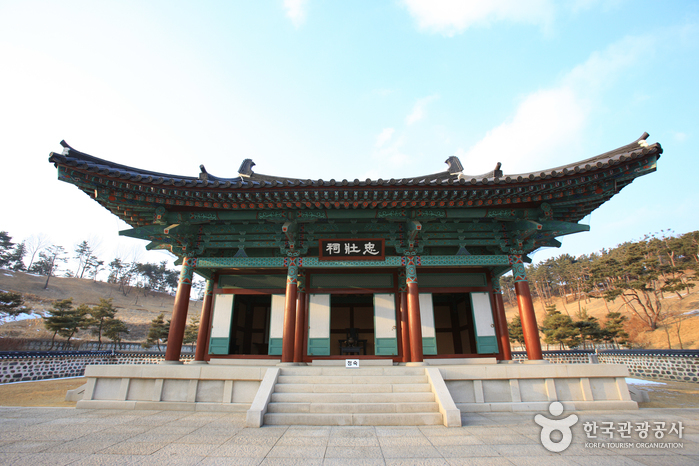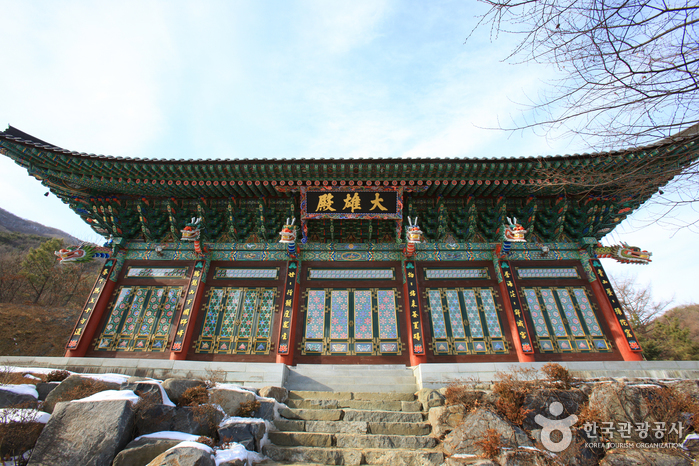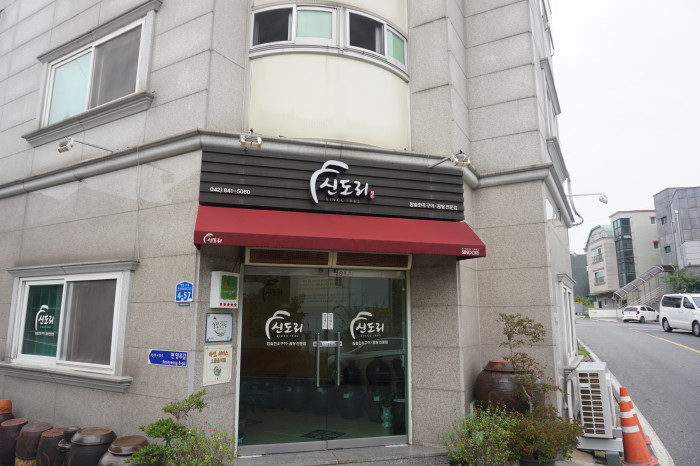Terminal des bus express de Yeonmudae Kumho
8.6 Km 2540 2015-11-09
1125 Ansim-ri Yeonmu-eup Nonsan-si Chungcheongnam-do
Festival des produits de la mer en saumure de Ganggyeong (논산 강경젓갈축제)
8.7 Km 5281 2022-09-22
45, Geumbaek-ro, Nonsan-si, Chungcheongnam-do
- Ligne Info Tourisme : +82-41-1330 (coréen, anglais, japonais, chinois) - Pour obtenir plus d'info +82-41-746-5904 (coréen)
Ganggyeong est bien connu pour son marché des produits de la mer fermentés, le plus grand en Corée.
Ce marché traditionnel, vieux de 200 ans, possède des produits frais et en saumure, fermentés à basse température. Le marché fournit la moitié des produits de la mer en saumure du pays.
Vous aurez la possibilité d'acheter les produits de 30 à 40% moins chers durant le festival.
Site historique du Général Gyebaek (계백장군 유적지)
9.0 Km 12830 2020-06-18
14, Sinpung-ri, Bujeok-myeon, Nonsan-si, Chungcheongnam-do
+82-41-746-8431
Gyebaek (? - 660) était un général de l’ancien royaume coréen de Baekje. Le site historique se trouve non loin de Hwangsanbeol, le dernier champ de bataille où le general Gyebaek est tombé en défendant Baekje lors de ses derniers jours. Les troupes alliées de Silla et de la Chine des Tang attaquèrent Tanhyeon et Baekgang, deux sites stratégiques tenus par Baekje en 660 (20ème année du règne du roi Uija). Le général Gyebaek et ses 5 000 soldats combattirent le général Kim Yu-Sin et ses 50 000 hommes. Le général Gyebaek vainquit par quatre fois ses ennemis, mais finit par succomber sous le nombre des soldats de l’armée adverse. L’armée de Baekje fut finalement vaincue, et Gyebaek, le dernier général de Baekje, tomba sur le champ de bataille.
Maison Myeongjae[Korea Quality] (논산 명재고택 [한국관광 품질인증])
9.0 Km 10549 2023-04-13
50, Noseongsanseong-gil, Noseong-myeon, Nonsan-si, Chungcheongnam-do
+82-41-735-1215, +82-10-6310-1139
Located in Noseong-myeon, Nonsan-si, Chungcheongnam-do, Myeongjae Historic House was built by Yun Jeung (pen-name: Myeongjae, 1629-1714), a scholar during the reign of King Sukjong (r. 1674-1720) of the Joseon Dynasty. It is said that although the king granted him a government post on eighteen occasions, Yun, being a straightforward sort of person, declined them all. As he practiced the virtue of simplicity and sharing in life and taught it to younger generations, the house escaped destruction during the Donghak Peasant Revolution (1894) and the Korean War (1950-1953) thanks to the efforts of his disciples. Thus, in keeping with his character, the house looks moderate compared to the homes of other aristocrats, although it exhibits a refined interior and a scientific design. The house consists of a sarangchae (men’s quarters), anchae (women’s quarters), and daecheongmaru (main floored room) configured in a square layout. The sarangchae itself consists of the keun sarangbang (large room) flanked by a daecheong and a numaru with an open view of the village and a mountain, the jakeun sarangbang (small room), the ansarangbang (inner room), and the daemungan (gate). To the right of the house is the spectacular sight created by a platform filled with hundreds of crocks for traditional sauces and condiments. The wall situated between the sarangchae and the anchae was designed to prevent people from looking into the anchae. There is also an open space below the wall from which one could see the shoes of a visitor, thus enabling the occupants of the anchae to know whether there was a visitor or not in the sarangchae. In addition, the gotganchae (storage quarters) situated next to the anchae is designed in such a way that it diminishes in size towards the north because the summer wind blowing from the south escapes the narrow passageway of the north, so it blows faster and the surrounding area gets colder, while the wind winter blowing from the north escapes the large passageway of the south, protecting the building from the bitter wind of the north. Therefore, the storeroom at the north end of the gotganchae remains cool even in summer, thereby preserving the things (food and other commodities) stored there. The guestrooms of the house include the three sarangbang rooms in the sarangchae building and the geonneonbang (a room opposite the main living room) in the anchae. The entire sarangchae building including the numaru can be rented too. Guests can also rent the thatched-roof byeolchae in the courtyard, which features a choyeondang equipped with a sound system and a beam projector, as well as a modern bathroom, for group meetings or performances. The house also runs a variety of paid traditional experience programs including Gukak (Korean classical music), tea ceremony, natural dyeing, and so on. Other noteworthy features of the house include the sarangchae’s distinctive gate, which combines a sliding door with a hinged door, the looming presence of a mountain to its rear, and the little round island (pond) planted with an old crape myrtle at its front.
Baek il heon Head House [Korea Quality] / 논산 백일헌 종택 [한국관광 품질인증]
9.8 Km 9208 2020-09-08
45, Jugok-gil, Sangwol-myeon, Nonsan-si, Chungcheongnam-do
+82-41-736-4166 / +82-10-2911-4166
The Baegilheon Head House (National Folklore Cultural Heritage No. 273) is the house that was bestowed upon General Yi Sam by King Yeongjo in recognition of his achievement in suppressing the Yi In-jwa Rebellion in 1728. King Yeongjo also granted Yi Sam the posthumous name ‘Baegilheon’. The house is composed of the munganchae (gate quarters) situated next to a tall gate, the ‘ㄷ’-shaped anchae (women’s quarters), and the ‘ㄱ’-shaped sarangchae (men’s quarters), which are configured in an overall square layout. The accommodation includes the munganchae, the araet sarang with a numaru (upper floor), and the wit sarang and the geonneotbang, each of which has a large toenmaru (a narrow wooden porch running along the outside of the building). Notably, the geonneotbang, which is connected with the daecheong (wooden floor) and has a cozy courtyard surrounded by a mud wall, was the living space for the eldest son of the family and his wife for many generations. As the house has been designated as a National Folklore Cultural Heritage, cooking in the guestrooms is strictly prohibited. However, the house provides breakfast prepared by the daughter-in-law of the head house free of charge. The toilets and shower room are situated in the back yard.
Evergreen Hotel (에버그린 관광호텔)
11.8 Km 8114 2020-03-30
369, Hwanghwa-ro, Nonsan-si, Chungcheongnam-do
+82-41-742-3344
Evergreen Hotel is the only tourist hotel in Nonsan. The hotel has 40 comfortable rooms and 2 banquet halls, a seminar room, coffee shop, live café, buffet, and sauna.
Tombes royales de Baekje (anciennes tombes de Neungsan-ri) [Patrimoine mondial de l'UNESCO] (부여 능산리 고분군)
14.3 Km 7088 2020-04-22
61, Wangneung-ro, Buyeo-gun, Chungcheongnam-do
+82-41-830-2890
Des centaines de tombes de Baekje sont éparpillées à Buyeo. Parmi elles, les anciennes tombes de Neungsan-ri, proches de Buyeo, sont grandes et ont été relativement bien conservées.
Les anciennes tombes de Neungsan-ri ont été les tombes royales de la dynastie Baekje de 538 à 660, lorsque la capitale de Baekje était Sabi (actuelle Buyeo). Dans le musée du Gobun miniature de Baekje, situé à l’entrée des anciennes tombes de Neungsan-ri, des reconstitutions et des miniatures de tombes sont exposées, dont on peut voir l’intérieur. On peut y contempler toutes sortes de tombes de Baekje, parmi lesquelles des monticules de pierre de l’ère Hanseong, et ceux découverts à Buyeo.
Temple Musangsa (무상사)
14.7 Km 4092 2023-04-13
129, Hyangjeoksan-gil, Eomsa-myeon, Gyeryong-si, Chungcheongnam-do
+82-42-841-6084
Le temple Musangsa est un lieu réputé notamment comme lieu de séjour pour les moines étrangers qui viennent effectuer des séjours pour pratiquer le Ganhwaseon (une sorte de bouddhisme zen). Il est aussi possible de participer à des programmes de 3 mois autour des traditions bouddhistes en Corée.
Les bouddhistes mais aussi les visiteurs peuvent prendre part à des activités de méditation pour une durée d’une semaine. Pendant cette période de méditation, les visites du public sont limitées. Le temple Musangsa, un temple zen international spécialement conçu pour les étrangers, fut créé par le moine Sungan en mars 2000 dans le but de promouvoir le bouddhisme zen coréen parmi le public étranger tout en encourageant et aidant les religieux non bouddhistes à faire l'expérience pratique du concept ‘zen’.
Situé au pied du moint Gyeryong, le temple est entouré par une forêt de pins, rendant le lieu parfait pour apprécier la beauté naturelle et originelle des forêts en Corée.
Sindo-ri Hanuchon (신도리한우촌)
15.9 Km 110 2021-03-20
4-57, Beonyeong, 11-gil, Eomsa-myeon, Gyeryong-si, Chungcheongnam-do
+82-42-841-5060
A restaurant run for 35 years by a representative of fermented dishes. This Korean dishes restaurant is located in Gyeryong-si, Chungcheongnam-do. The most famous menu is grilled Korean beef.
Festival Sanshinje du mont Gyeryongsan (계룡산 산신제)
16.1 Km 640 2020-09-04
165, Yanghwa-ri, Gyeryong-myeon, Gongju-si, Chungcheongnam-do
• Ligne Info Tourisme : +82-41-1330 (coréen, anglais, japonais, chinois) • Pour obtenir plus d'info : +82-41-840-8090
Sur l’une des montagnes sacrées de Corée, le mont Gyeryongsan, se trouve le second parc national après celui de la montagne Jirisan.
Le mont Gyeryongsan regorge de charmes uniques à toutes les saisons. Au printemps, le mont se remplit de vitalité printanière et montre de magnifiques couleurs. La rue amenant au temple Donghaksa est particulièrement belle, entourée de cerisiers en fleurs. Le festival culturel des cerisiers du mont Gyeryongsan se déroule à cet endrois précis.



![Maison Myeongjae[Korea Quality] (논산 명재고택 [한국관광 품질인증])](http://tong.visitkorea.or.kr/cms/resource/40/1878940_image2_1.jpg)
![Baek il heon Head House [Korea Quality] / 논산 백일헌 종택 [한국관광 품질인증]](http://tong.visitkorea.or.kr/cms/resource/98/2530098_image2_1.jpg)
![Tombes royales de Baekje (anciennes tombes de Neungsan-ri) [Patrimoine mondial de l'UNESCO] (부여 능산리 고분군)](http://tong.visitkorea.or.kr/cms/resource/31/212931_image2_1.jpg)


 Français
Français
 한국어
한국어 English
English 日本語
日本語 中文(简体)
中文(简体) Deutsch
Deutsch Español
Español Русский
Русский